Market & Macroeconomic Analysis 4Q24
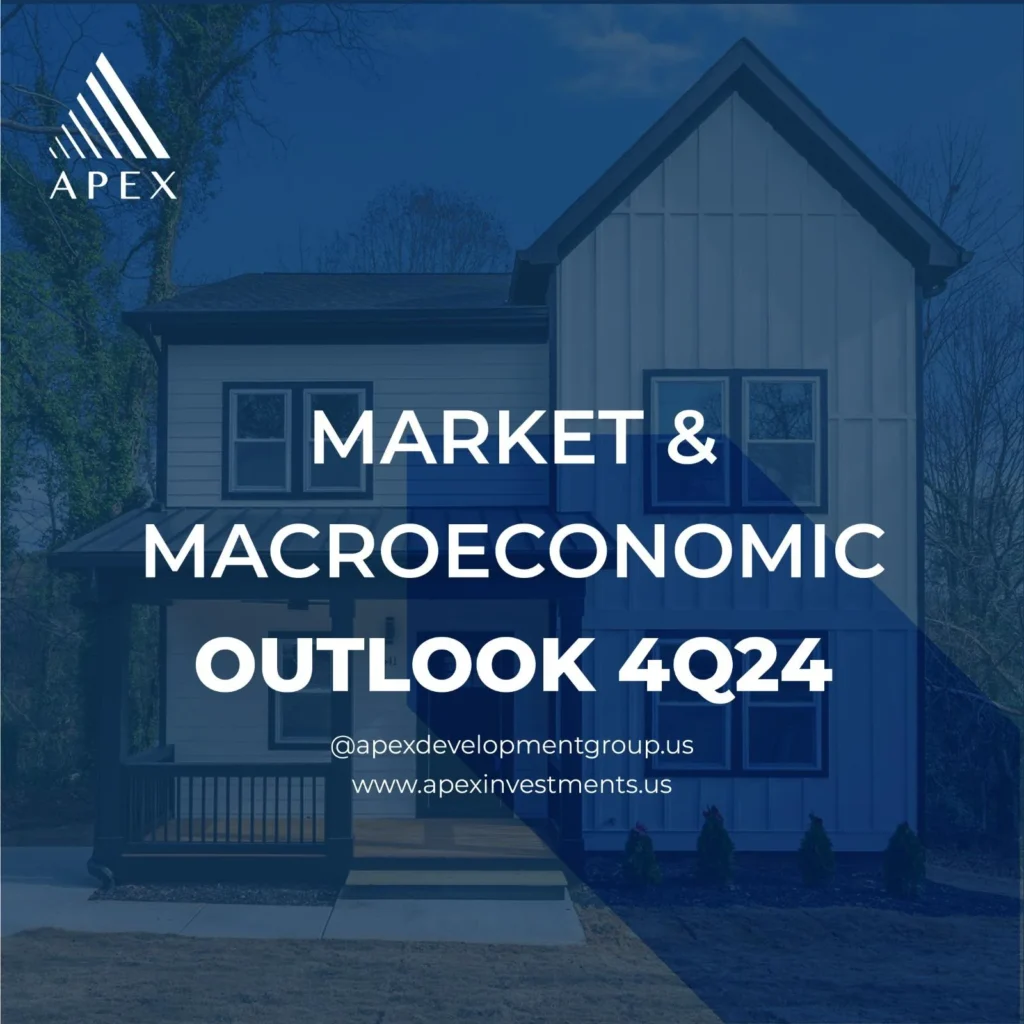
Home Market & Macroeconomic Analysis 4Q24 Blog · May 20, 2025 The year 2024 concluded with a robust U.S. economy and initially positive inflation forecasts that later became uncertain. Despite strong U.S. growth, global markets faced challenges such as slowing economic momentum, political conflicts, geopolitical tensions, and currency fluctuations. The Federal Reserve’s controversial “hawkish cut” sparked significant debate, while investors began focusing on the potential impacts of the Trump administration’s policies, introducing considerable uncertainties for 2025.The last quarter of 2024 indicated a steady economic environment for the United States, particularly following the Federal Reserve’s recent decisions, which always play a crucial role in shaping the economic environment. In this Market Outlook 4Q24 U.S. Economy analysis, we will examine key indicators such as the Core Consumer Price Index (CPI), GDP growth, and unemployment rates. Core CPI In December 2024, the Consumer Price Index report brought some relief. The Core CPI, a measure that excludes volatile food and energy costs, indicated that price increases were slowing down. It rose by just 0.2% from the previous month, a smaller increase than the 0.3% monthly increases seen in the three months prior. Looking at the bigger picture, the Core CPI was 3.2%, a decrease from the 3.3% year-over-year observed in November 2024. This trend is crucial for policymakers and investors as it impacts purchasing power and interest rate decisions. Source: US Bureau of Economic Labor Statistics GDP GDP Real gross domestic product (GDP) increased at an annual rate of 2.4% in the fourth quarter of 2024. In the third quarter, real GDP increased 3.1 percent. The increase in real GDP in the fourth quarter primarily reflected increases in consumer spending and government spending that were partly offset by a decrease in investment. Imports, which are a subtraction in the calculation of GDP, decreased. Source: US Bureau of Economic Analysis Unemployment The unemployment rate was 4.2% in the fourth quarter of 2024. This rate reflects a slight increase from previous quarters but remained within a narrow range, indicating a relatively stable labor market. Employment gains were observed in sectors such as healthcare, professional services, and government, while manufacturing and retail experienced slower growth. The Federal Reserve’s recent rate cuts aim to support economic growth and prevent further job erosion. Monitoring these trends will be essential for understanding the broader economic outlook as we move into 2025. Source: US Bureau of Labor Statistics Conclusion The fourth quarter of 2024 showcased a resilient and dynamic U.S. economy, despite facing several global challenges. Key economic indicators such as GDP growth, Core CPI, and unemployment rates provided a comprehensive view of the economic landscape. This Market Outlook 4Q24 U.S. Economy highlights how the Federal Reserve’s decisions, including the “hawkish cut,” played a crucial role in shaping the economic environment, sparking debate and influencing market dynamics. While the U.S. economy demonstrated strength, global markets contended with slowing momentum, political strife, geopolitical tensions, and currency volatility.
Market & Macroeconomic Analysis 1Q25
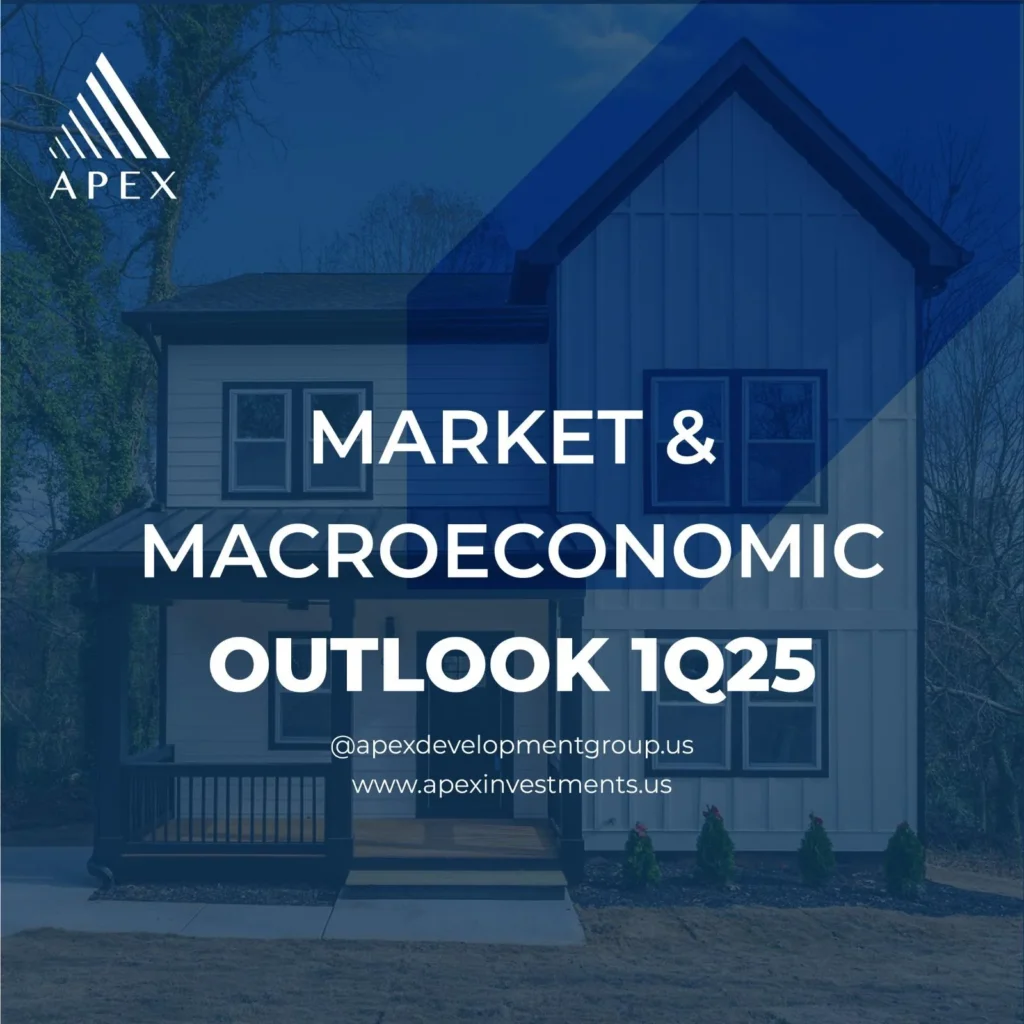
Home Market & Macroeconomic Analysis 1Q25 Blog · May 20, 2025 The first quarter of 2025 showed a strong US economy mostly driven by consumer spending but considerably full of uncertainty. This first quarter presented a complex and evolving economic landscape for the United States, particularly influenced by a new administration that was noted by drastically cutting federal spending and making big changes to trade, impacting financial markets significantly. The administration created a lot of uncertainty in the markets, made people expect higher inflation, and led to strong negative responses from other countries. This Market Outlook 1Q25 U.S. Economy analysis delves into key indicators. GDP The Gross Domestic Product, sum of all the goods and services produced, and variable that is taken as the lead indicator of the U.S. economy, contracted at an annualized rate of 0.3% (Advance Estimate) in the first quarter of 2025, marking the first decline since the first quarter of 2022. This estimated contraction might be primarily driven by a surge in imports and a decrease in government spending, which indicated to be partially offset by increases in investment, consumer spending, and exports. Compared to the previous quarter’s growth of 2.4%, this estimated decline reflects significant economic challenges. Negative GDP growth is rare for the U.S., occurring just three times over the last decade: 2020’s first two quarters as the COVID-19 crushed the global economy, and Q1 2022, when the economy faced rising inflation, leading the Federal Reserve to increase interest rates for the first time in more than three years. Source: US Bureau of Economic Analysis Unemployment The unemployment rate remained stable at 4.2% in Q1 2025. This rate has fluctuated within a narrow range since mid-2024, indicating a steady labor market. Employment gains were observed in sectors such as healthcare, social assistance, and transportation, while federal government employment declined. The stability in the unemployment rate suggests that the labor market is resilient, although the pace of job creation has slowed compared to previous years. Source: US Bureau of Labor Statistics Core CPI In March, the index for all items excluding food and energy increased by a small 0.1 percent, a slower rate than the 0.2 percent rise in February. Also, Inflation in all items excluding food and energy showed a 2.8% increase over the last 12 months, the slowest yearly growth since March 2021. Source: US Bureau of Economic Labor Statistics Conclusion The first quarter of 2025 reflected a complex economic environment in the U.S., shaped by a contracting GDP, policy-driven uncertainty, and shifting global dynamics. Despite a resilient labor market and a modest slowdown in inflation, the economy showed early signs of stress—marked notably by a rare GDP contraction of 0.3%. The new administration’s aggressive fiscal cuts and abrupt changes to trade policy introduced increased volatility, impacting both domestic sentiment and international relations. While consumer spending and select sectors like healthcare and transportation provided some stability, the overall outlook remains cautious. Investors and businesses will need to navigate a landscape that demands adaptability, risk awareness, and a keen focus on evolving macroeconomic signals. This Market Outlook 1Q25 U.S. Economy provides crucial insights for navigating these shifts. As economic signals shift, Apex Development Group remains focused on delivering investment strategies backed by real estate fundamentals, professionalism and experience. Previous PostMarket & Macroeconomic Analysis 3Q24Next PostMarket & Macroeconomic Analysis 4Q24
Market & Macroeconomic Analysis 3Q24
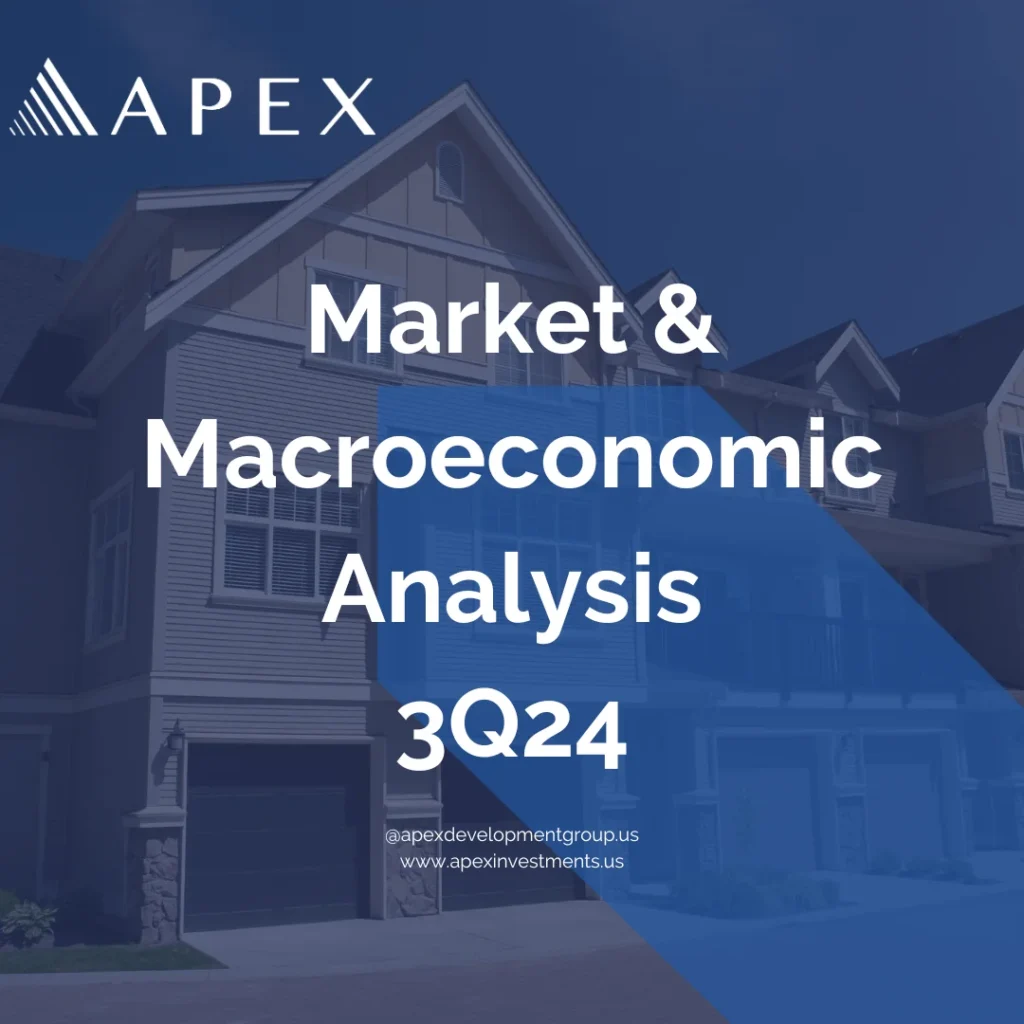
Home Market & Macroeconomic Analysis 3Q24 Blog · October 31, 2024 The third quarter of 2024 has presented a stable yet intriguing economic landscape for the United States, mostly after the FEDs recent decisions that always play a crucial role in shaping the economic landscape. For this Market & Macroeconomic Analysis of 3Q24 we analyze key indicators such as the core Consumer Price Index (CPI), GDP growth, and unemployment rates have shown consistent trends, reflecting the underlying health and dynamics of the economy. Here we’ll analyze the behavior of these variables, their past data, tendencies, and the implications for future economic conditions. Core CPI Core CPI The core CPI, which excludes volatile food and energy prices, showed a slight increase from 3.2% in August to 3.3% in September 2024. This marks a modest rise in underlying inflationary pressures, following a gradual decline from earlier in the year. The core CPI started the year at 3.9% in January and has generally trended downward, indicating some easing of inflation at the moment. However, the recent uptick suggests that inflationary pressures are not entirely subdued and may be influenced by factors such as wage increases and supply chain issues.Typically, there is an inverse relationship between inflation and unemployment, known as the Phillips curve. However, the data showed both core CPI and unemployment rates remained relatively stable. This could indicate that the economy is in a phase where inflationary pressures are not significantly driven by labor market conditions, possibly due to other factors like productivity gains or global economic influences. Source: US Bureau of Economic Analysis GDP Growth The GDP growth rate has been steady at 0.3% each month throughout 2024. This consistent growth reflects a stable economic environment, with no significant acceleration or deceleration. The steady GDP growth suggests that the economy is expanding at a moderate pace, which is generally positive for long-term economic health and is a sign of resilience for the US economy. Despite widespread predictions of a recession, the economy has continued to grow, with hiring and consumer spending remaining steady.Given the recent economic data, including the modest increase in core CPI and stable GDP growth, the Federal Reserve faces a complex decision-making environment. While a gradual rate cut is anticipated, the Fed’s primary objectives of achieving maximum employment and price stability remain paramount. Source: US Bureau of Economic Analysis Unemployment Rate The unemployment rate has shown minor fluctuations, ranging from 4.0% to 4.2% throughout the year. Starting at 3.9% in January, it peaked at 4.2% in June and July before stabilizing at 4.1% in September. This stability suggests a balanced labor market, where job creation is keeping pace with the number of people entering the workforce. The slight increase in the middle of the year could be attributed to seasonal factors or temporary economic adjustments. Source: US Bureau of Labor Statistics ¿What about the FED? In the third quarter of 2024, the Federal Reserve made a significant decision to cut interest rates by 0.50%, marking the first rate cut since 2020. This decision was driven by a combination of rising unemployment, and inflation moving back towards the Fed’s 2% target. However, this decision comes with complications. While lower interest rates can boost economic growth and reduce unemployment, they also risk reigniting inflation if not managed carefully. The Fed’s challenge is to balance these competing priorities, ensuring that the economy continues to grow without triggering excessive inflation. Conclusion The third quarter of 2024 reflects a stable and balanced economic environment in the United States. While the slight increase in core CPI requires close monitoring, the overall economic indicators suggest a soft landing and continued economic resilience. The Federal Reserve’s decision to cut interest rates highlights the delicate balance policymakers must maintain between supporting growth and controlling inflation. Moving forward, close attention to these economic indicators, along with the US elections, will be crucial in navigating the complexities of the current economic landscape.
Market & Macroeconomic Outlook 2Q24 + FED’s bonus

Home Market & Macroeconomic Outlook 2Q24 + FED’s bonus Blog · August 15, 2024 Fed Sees Progress on Inflation, Rate Cuts Could Be in Sight After the numbers given in the market & macroeconomic Outlook of 2Q24, the Federal Reserve concluded its latest monetary policy meeting with a decision to maintain interest rates unchanged. The central bank emphasized its continued commitment to achieving both maximum employment and price stability, the dual mandate assigned by Congress. While acknowledging substantial progress in taming inflation, which has fallen from a peak of 7% to 2.5%, the Fed stressed the need for persistent efforts to bring inflation back to its 2% target. To this end, the central bank will continue monitoring economic data closely and stands ready to adjust monetary policy as needed to address evolving conditions.The economy has shown signs of moderation in recent months. GDP growth has cooled to 2.1% from 3.1% in the previous year, and consumer spending, though still robust, has softened from its rapid pace of the prior year. The unemployment rate has ticked up slightly to 4.1% but remains at a historically low level.The Fed’s decision to maintain rates reflects a delicate balancing act between supporting economic growth and curbing inflationary pressures. By holding rates steady, policymakers aim to allow the economy to gradually adjust to a less accommodative monetary policy stance while keeping inflation expectations anchored.The central bank reiterated its data-driven approach, indicating that future policy decisions will hinge on the incoming economic data. While inflation has eased significantly, policymakers remain vigilant and prepared to act if necessary to achieve their dual mandate goals. Economic Overview GDP Gross Domestic Product (GDP) growth rates showed resilience, indicating a robust economic activity amidst challenging conditions, proving how strong the US economy is. The U.S. Bureau of Economic Analysis has released an “advance” estimate indicating that the real gross domestic product (GDP) increased at an annual rate of 2.8 percent in the second quarter of 2024. This represents a significant increase from the first quarter, during which the real GDP increased by 1.6 percent. The increase in real GDP primarily reflected increases in consumer spending, private inventory investment, and nonresidential fixed investment.It’s important to note that this GDP is an estimate and a more comprehensive “second” estimate for the second quarter is scheduled for release on August 29. Source: US Bureau of Economic Analysis Core CPI Inflation, measured by the core CPI (Consumer Price Index) fell 0.1% in June, showing a year-over-year increase of 3.3% in June, one of the lowest monthly growth rates since the pandemic began. This marks a more significant decrease from the previous month’s reading, offering more than just a hint of potential moderation in inflationary pressures. However, it’s important to consider that it is still above target.While overall inflation still rose 3% annually, this is a significant slowdown from the peak of 9.1% reached in June 2022. Source: US Bureau of Economic Analysis Unemployment Job growth accelerated in June, with payrolls increasing by a solid 206,000. While this was better than anticipated, the unemployment rate edged up to 4.1%. Revisions to earlier data indicate slightly weaker hiring in April and May, bringing the average job gains for the quarter to 177,000 per month.While unemployment rate is still historically in the lows, this increase, combined with underwhelming job growth, has raised concerns about a potential economic slowdown. As a result, expectations for a Federal Reserve interest rate cut in September have grown, with policymakers facing pressure to stimulate economic activity and prevent a more severe downturn. Source: US Berau of Labor StatisticsThe second quarter of 2024 presented a complex economic landscape characterized by a delicate balancing act between fostering growth and taming inflation. While the Federal Reserve made progress in cooling inflation, the unexpected uptick in unemployment in July introduced a new layer of uncertainty. Despite these challenges, the central bank maintained a cautious stance, holding interest rates steady while closely monitoring economic indicators. As the Federal Reserve navigates this complex terrain, market participants will be closely watching for signs of a potential rate cut in September, and its implications for both economic growth and inflation.The interplay between monetary policy, labor market conditions, and inflation will continue to shape the overall economic outlook in the coming quarters.
Market & Macroeconomic Outlook 1Q2024
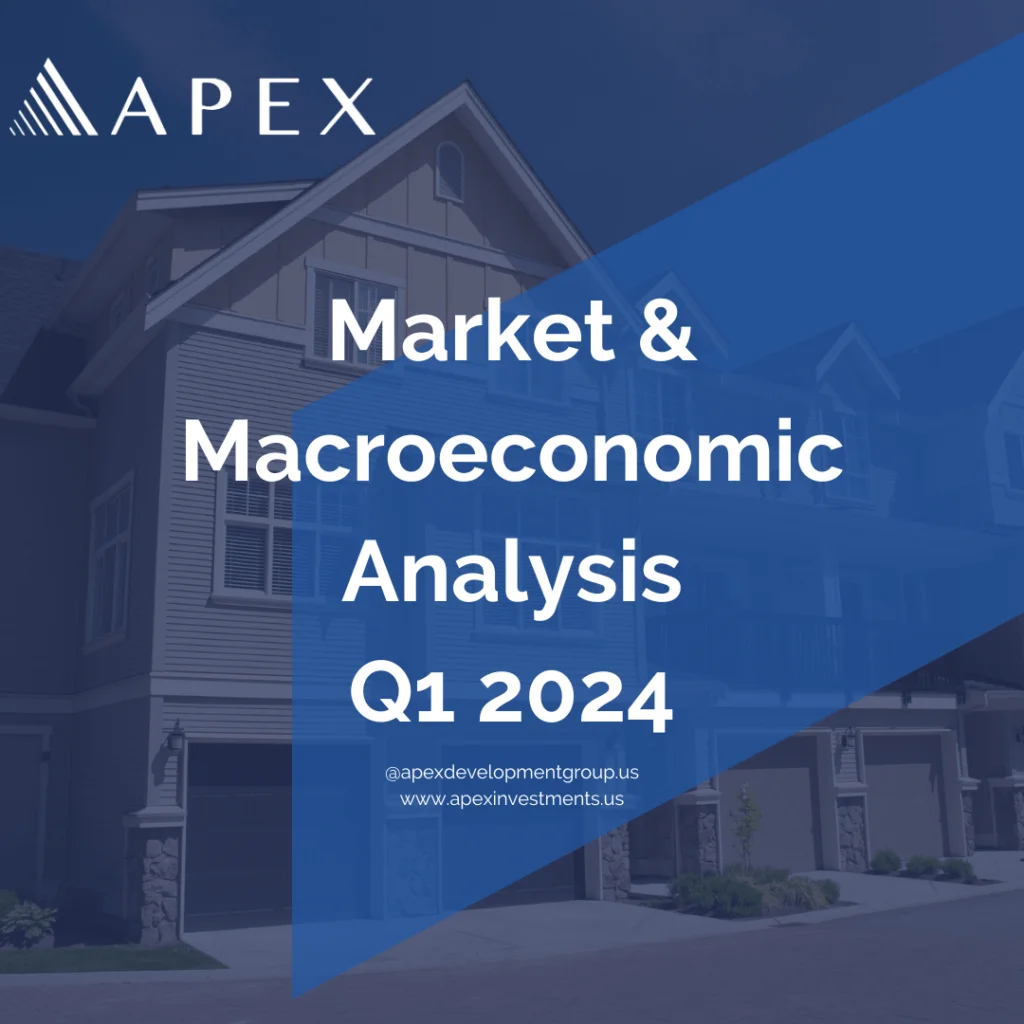
Home Market & Macroeconomic Outlook 1Q2024 Blog · April 16, 2024 This analysis examines macroeconomic forces that shaped the US market in the first quarter of 2024. This Market Outlook 1Q2024 explores key economic indicators to understand the overall health of the economy during this period. Economic Overview SOFR Forward Curve The 1-month SOFR forward curve reveals a dynamic shift in market expectations for interest rates. The upward slope indicates an anticipation of rising SOFR rates, particularly in the near term (March-June 2024) compared to previous flatter trajectories. This might reflect concerns about persistent inflationary pressures. If market participants believe inflation remains above desired levels, they may expect the Federal Reserve to continue tightening monetary policy, holding “higher for longer”. Source: Chatam Financial GDP The US economy grew at an annual rate of 3.2% in the fourth quarter of 2023, down slightly from the 4.9% growth observed in the third quarter. The increase in real GDP was driven by growth in consumer spending, exports, government spending (both state and federal), and investment in nonresidential fixed assets (e.g., factories, offices). Private inventory investment decreased in Q4, partially offsetting the positive contributions from other sectors. The previously reported growth rate for Q4 was 3.3%, which has been revised down slightly to 3.2%.This report suggests the US economy continued to expand in Q4 2023, although at a slower pace compared to Q3. Consumer spending remains a key driver of growth. Source: US Bureau of Economic Analysis Soft Landing In 2024? Economists like UBS, Morgan Stanley, JP Morgan Chase, Goldman Sachs, between others, are predicting moderate US GDP growth in 2024, with forecasts ranging from a slight decline to nearly 3%. This follows a trend of stronger growth in recent years. The consensus forecast sits around 2.3%, and factors like consumer spending and interest rate adjustments will influence the final outcome.Overall, the economists’ forecasts suggest a moderate GDP growth for the US in 2024 compared to recent years. This could be a sign of a soft landing for the US economy, where inflation subsides without triggering a recession. Source: US Bureau of Economic Analysis, WorldBank Core CPI The latest US core CPI data, shows a year-over-year increase of 3.8%. This marks a slight decrease from the previous month’s reading of 3.9%, offering a hint of potential moderation in inflationary pressures. However, it’s important to consider several factors: Still Above Target: Core CPI remains well above the Federal Reserve’s long-term target of 2%. This sustained inflation could lead the Fed to continue tightening monetary policy. Month-over-Month Changes: While the year-over-year comparison shows some moderation, a closer look at month-over-month changes is necessary. Analyzing the most recent month’s core CPI compared to the previous month can reveal the current inflationary trend. Source: US Bureau of Labor Statistics Unemployment February’s unemployment rate of 3.9% represents a 0.2% increase compared to January’s 3.7%. This uptick snaps a 3-month of steady or declining streak (Dec. 2023 – Feb. 2024) and warrants closer examination.While it remains near historic lows, the increase could signal a turning point in the labor market. There are two main possibilities: Normal Fluctuation: The labor market is dynamic, and slight monthly ups and downs are not uncommon. Shifting Landscape: An increase in labor force participation could contribute to a higher unemployment rate, even if job creation remains steady. This could indicate a change in the economic environment or worker behavior. Source: US Bureau of Labor Statistics By understanding this key factors in the market outlook 1Q24, investors can make more informed decisions about where to allocate their capital. Examining both the big picture and the granular details of industry performance paints a comprehensive portrait of the market landscape, allowing for a more nuanced investment strategy.
Key Trends to Watch in 2024

Home Key Trends to Watch in 2024 Blog · February 7, 2024 Maximize Your Multifamily Investment As a leading multifamily sponsor, we provide investors with expert guidance and access to exclusive opportunities. By understanding the key trends shaping the market in 2024, we help you navigate the dynamic landscape and maximize your investment potential.The US multifamily market in 2023 presented a complex picture, marked by both challenges and opportunities. Rising interest rates, property insurance costs, construction expenses, and cap rate compression widened the gap between investors and property owners throughout the year. Looking ahead to 2024, we anticipate a dynamic market with several key trends shaping the landscape: 1. The New Supply Challenge The delivery of over 670,000 new units in 2024 poses a significant challenge that’s hasn’t been seen since 1960-1970s when a significant housing supply impacted the US market. This inflow may trigger tenant migration from Class B and C properties to newer options with better amenities and technology at slightly higher rents. Landlords will need to redefine rent pricing strategies, prioritizing tenant retention over aggressive rent increases. 2. Sustained Demand, Stabilizing Supply: Despite the new supply, robust demand for housing is expected to persist in 2024, driven by high home prices and limited affordability options. This strong demand should help maintain stable absorption of new units, mitigating concerns about oversupply. 3. Refinancing Wave and Transaction Activity: Many property owners with short-term, variable-rate loans originated between 2020 and 2022 will seek refinancing options as these loans mature. This, coupled with stabilizing interest rates, is expected to lead to increased transaction volume in the multifamily market. 4. Cap Rate Normalization: Cap rates, which have been compressed, are starting to stabilize and gradually decompress across the country. Projections suggest they may settle around the mid 5% range in 2024, with a potential further increase to 6% or mid 6%. However, some anticipate compressed cap rates to persist in the first half, particularly for new products in good locations, while old products will tend to have a normal transaction. 5. Market Volatility and Opportunistic Approach: We expect a volatile market in the early months of 2024, gradually transitioning towards normalization later in the year. Despite the challenges, we remain bullish on the multifamily market. Our approach continues to emphasize thorough underwriting and an opportunistic stance to identify and capitalize on attractive deals.In conclusion, the US multifamily market in 2024 will be characterized by ongoing adjustments and evolving dynamics. By understanding these trends and adopting a strategic approach, investors can navigate the complexities and unlock opportunities for success. Partnering with an experienced sponsor like Apex can provide invaluable guidance and expertise in navigating the ever-changing multifamily landscape. We turn challenges into opportunities, navigating the complexities and capitalizing on trends explained before requires experience and foresight. Our proven track record and in-depth market knowledge ensure informed decisions. We identify undervalued assets, secure optimal financing solutions, and implement strategic rent pricing strategies to maximize investors’ returns.
Why is the Fed Raising Interest Rates?
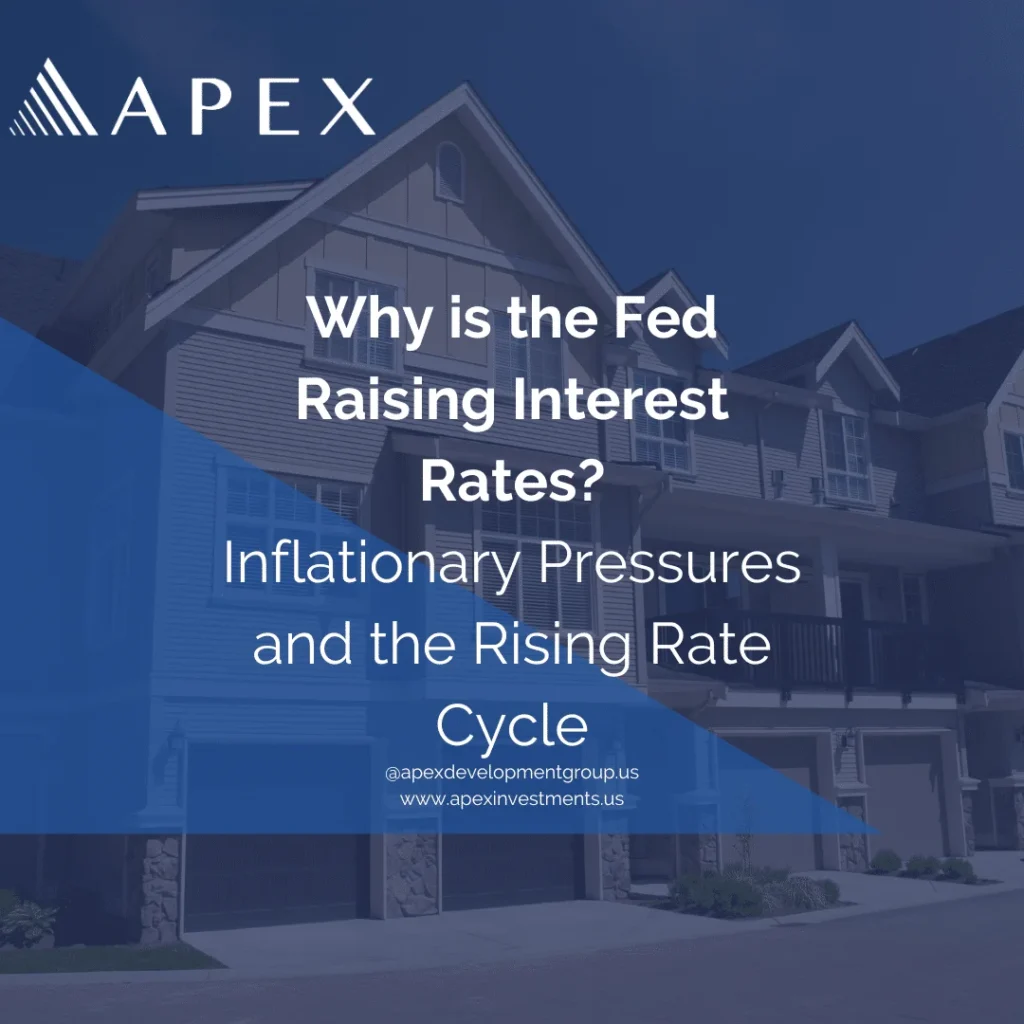
Home Why is the Fed Raising Interest Rates? Blog · October 2, 2023 Inflationary Pressures and the Rising Rate Cycle In 2022, the FED began raising interest rates in response to rising inflation. This rate-hiking cycle has continued into Q3 2023 and is expected to continue at least until the end of 2023. In this article, we will briefly analyze the factors that contributed to inflation reaching its highest level in 40 years and how this led to the current interest rate hike cycle. Source: Newyorkfed.org Inflation Inflation is a general increase in prices and a decrease in the purchasing power of money, think of inflation as a generalized increase in prices of goods and services. Inflation can also be a product of scarcity if a product that is in high demand suddenly starts to be unavailable, then the price will rise rapidly. If this product is vital for a sound economy, this scarcity will lead to it. It can be caused by several factors, including: Increased demand: When demand for goods and services exceeds supply, businesses can raise prices. Decreased supply: When the supply of goods and services is disrupted, businesses may raise prices to compensate. Cost-push inflation: When the cost of producing goods and services increases, businesses may pass on these costs to consumers in the form of higher prices. The main factor that drives the tendency of interest rates is inflation. In an organized economy, this increase usually follows a long cycle of low interest rates, higher than expected economic growth, and a high volume of money being injected into the economy via investment or government incentives. All the aforementioned factors lead to more money in circulation in the economy. If businesses and homes have more cash in hand, they will increase their demand for services and goods which will lead producers to set their prices higher. What was the behavior during the past pandemic? The COVID-19 pandemic caused a sudden halt to business activities in the first half of 2020. Global mandatory quarantines forced all but essential businesses to close, leading to widespread bankruptcies, layoffs, and shortages of several goods and services. As a result, people and businesses clinched to their available cash and significantly decreased their consumption, investments and put a stop on their growth plans. A prolonged decline in goods and services would have put the US economy in a hard place.To incentivize consumption, the US government created multiple aid programs for businesses and individuals designed to get cash circulating into the economy, including loans with interest rates close to zero, payroll subsidies, tax deductions, and government checks. At the same time, the FED was drastically reducing interest rates until they reached levels that were close to zero. This exponential diminish cycle was later known as “free money”.After vaccines became widely available and quarantine ended, most of the world quickly returned to normal, businesses reopened, and the panic went away. Nevertheless, the economy was already flooded with cash. After that, the tables turned, and the large amount of cash in circulation led to the highest inflation the US has seen in 40 years.As it is widely known, the FED’s main role is to keep inflation under 2%, and in June 2022 it reached 9.06%. As a result, the goal was to get inflation back to its target level so the way to achieve this was via interest rate. Since then, the Fed initiated a rate hike cycle that is likely to continue as of September 2023. In fact, the Effective Federal Funds rate has gone from 0.25% to 5.25%, the steepest increase since the Volcker Shock in the 1980s.As of August 2023, data revealed that core inflation sits at 4.35%. Even though it has drastically decreased from 9.06%, it is still more than double the target inflation of 2%. FED’s chair, Jerome Powell, has hinted that the interest rate hike cycle will keep on going until there is convincing evidence that the 2% goal will be achieved. It is important to note that raising interest rates can have a negative impact on the economy. Higher interest rates can make it more expensive for businesses to borrow money and invest, and it can also make it more expensive for consumers to borrow money to buy homes and vehicles. However, the FED believes that raising interest rates is necessary in order to control inflation and protect the long-term health of the US economy.To summarize, the COVID-19 pandemic had a significant impact on inflation and monetary policy. Government stimulus programs and the Fed’s low interest rates led to a large increase in the money supply. When the pandemic subsided and businesses reopened, this influx of cash fueled a surge in inflation. The Fed is now raising interest rates to bring inflation back down to its target level of 2%. The Relationship Between Inflation and real estate The Fed has been raising interest rates aggressively in an effort to bring inflation back to its target level. The Fed has raised interest rates four times in 2023, with the most recent hike being a 25 basis points increase in July. The rising rate cycle is having a significant impact on the real estate market as higher interest rates make it more expensive to borrow money to buy a property. This is leading to a decrease in demand for homes and a slowdown in the housing market with a notorious impact on inventory levels and absorption rates.The Fed’s rate hikes are also having an impact on home prices. Home prices have been rising rapidly in recent years, but the pace of growth is starting to moderate. This is due, in part, to the higher interest rates, which are making it more expensive for buyers. The real estate market is likely to remain under pressure for the foreseeable future as the Fed continues to raise interest rates. However, the long-term impact of the rising rate cycle on the real estate market is still uncertain.At Apex, as a real estate investment
Why Atlanta is One of The Hottest Market to Invest in Real Estate?

Home Why Atlanta is One of The Hottest Market to Invest in Real Estate? Blog · July 18, 2023 As the multifamily real estate market continues to gather attention from investors seeking stable returns and long-term growth, Atlanta emerges as a red-hot investment destination. Known for its vibrant economy, business-friendly environment, and strong housing market, Atlanta offers numerous reasons why savvy investors are turning their eyes to this dynamic city, making it one of the hottest market to invest in real estate. Is Atlanta a Good Economy? Atlanta has been known as one of the most economically robust cities in the nation thanks to its steady rise over the years. As the capital of Georgia and a major hub for finance, technology, logistics, and entertainment, Atlanta offers a diverse and thriving economy. Major corporations such as Delta Air Lines, The Coca-Cola Company, and UPS call Atlanta home, driving job creation and contributing to the city’s economic strength. With a steady inflow of new businesses and job opportunities, the demand for rental properties remains strong, making it an appealing choice for real estate investors.Also, the expanding tech sector in Atlanta has become a magnet for students and young professionals seeking promising career opportunities. As the city’s technology ecosystem continues to thrive, it offers a dynamic and innovative environment for individuals interested in pursuing tech-related careers. Leading tech giants and startups alike have set up shop in Atlanta, creating a vast array of job openings in fields such as software development, data analytics, artificial intelligence, and cybersecurity. Additionally, the presence of renowned educational institutions and research centers in the city further fuels the appeal of Atlanta as a hub for tech talent. With a promising job market and exciting prospects for career growth, more students are drawn to the city, contributing to its reputation as a promising tech hub and bolstering its overall appeal as a prime investment destination. Is Atlanta a Good Place for Business? Atlanta’s business-friendly environment has been a key factor in attracting both established companies and startups to set up shop in the city. Lower state taxes, favorable regulations, and a strategic geographical location make Atlanta a preferred destination for businesses looking to establish their roots and flourish. The city’s access to an extensive transportation network, including Hartsfield-Jackson International Airport, the world’s busiest airport, further cements its status as a business powerhouse. As businesses thrive, the demand for commercial and residential properties in Atlanta experiences a positive boost, presenting lucrative opportunities for investors. How Housing Prices Behave in Atlanta The Atlanta housing market has been on an upward trajectory, experiencing steady growth in home prices over the years. While this may raise concerns for some, it is important to note that the price appreciation reflects the city’s robust economic performance and population growth. Atlanta’s real estate market has shown resilience even during economic downturns, making it an attractive option for long-term investors seeking stability and capital appreciation. The rental market has witnessed strong demand, driven by an increasing number of millennials and young professionals opting for the flexibility of renting over homeownership. As a result, rental properties in Atlanta present a promising opportunity for investors looking for consistent cash flow and potential appreciation in property values.In conclusion, for investors seeking to capitalize on the multifamily real estate market’s potential, Atlanta stands out as one of the hottest market to invest in real estate. With its thriving economy, business-friendly environment, and steady growth in housing prices, Atlanta offers a winning combination of factors that make it a hot-spot for real estate investments. As the city continues to flourish and attract businesses and residents alike, investors can find a wealth of opportunities to build a successful and rewarding portfolio in this vibrant metropolis. Whether you’re an experienced investor or a rookie in the real estate market, Atlanta’s appeal as a top investment destination should be not ignored. So, take a closer look at Atlanta and unlock the boundless possibilities it offers for your real estate investment journey with APEX.
Five Reasons why the Southeast is great for Multifamily

Home Five Reasons why the Southeast is great for Multifamily Blog · May 29, 2023 When it comes to investing in the multifamily market, the US Southeast submarket stands out as a promising destination. If you’ve already made the decision to venture into multifamily real estate, you’re in for a treat. This article will examine five reasons that make the Southeast great for multifamily investments and a desirable location for multifamily opportunities, attracting investors with its potential for growth and profitability: Population Growth: The Southeast has witnessed significant population growth in recent years, a trend that is expected to continue over the next decade. Lower cost of living and numerous job openings in the area have attracted a considerable influx of both internal and external migration. Business-Friendly Environment: The Southeast boasts a business-friendly environment with lower state taxes and favorable regulations. This advantageous landscape has caught the attention of major corporations like Amazon, Microsoft, and Porsche, who have chosen to establish their operational hubs and, in many cases, headquarters in the Southeast region. Such corporate presence not only fuels economic growth but also creates a robust demand for rental properties, further enhancing the multifamily market’s potential. Development Opportunities: With friendly zoning regulations and thousands of acres of land available for development at competitive prices. The Southeast offer a great opportunity for Multifamily developers. Abundant Development Opportunities: With flexible zoning regulations and vast acres of land available at competitive prices, the Southeast presents a wealth of development opportunities for multifamily projects. As urban areas continue to expand, there is a growing need for quality housing, making multifamily development a highly promising venture. Landlord Friendly: The Southeast embraces flexible regulations, providing more freedom in terms of rent increases, lease contract terms, and renovation initiatives. This level of flexibility empowers multifamily investors to optimize their property’s potential, ensuring a smoother and more profitable investment experience. Thriving Economy: The Southeast region experiences robust economic growth, driven by a diverse range of industries including technology, manufacturing, and logistics. Notable companies such as Coca-Cola, Home Depot, UPS, as well as major cargo and passenger hubs like Hartsfield-Jackson, contribute to the region’s thriving economy. As the economy flourishes, so does the demand for rental properties, making multifamily investments even more enticing. In conclusion, the US Southeast submarket offers a surplus of compelling reasons to focus your multifamily investment endeavors here. The combination of population growth, business-friendly policies, development opportunities, landlord-friendly regulations, and a thriving economy positions the Southeast as a prime investment destination. Using these advantages and tapping into the region’s potential, you can unlock profitable opportunities and build a successful multifamily investment portfolio for a brighter and more prosperous future, utilizing these advantages and tapping into the potential.
Impact of Federal Interest Rates on The Multifamily Market
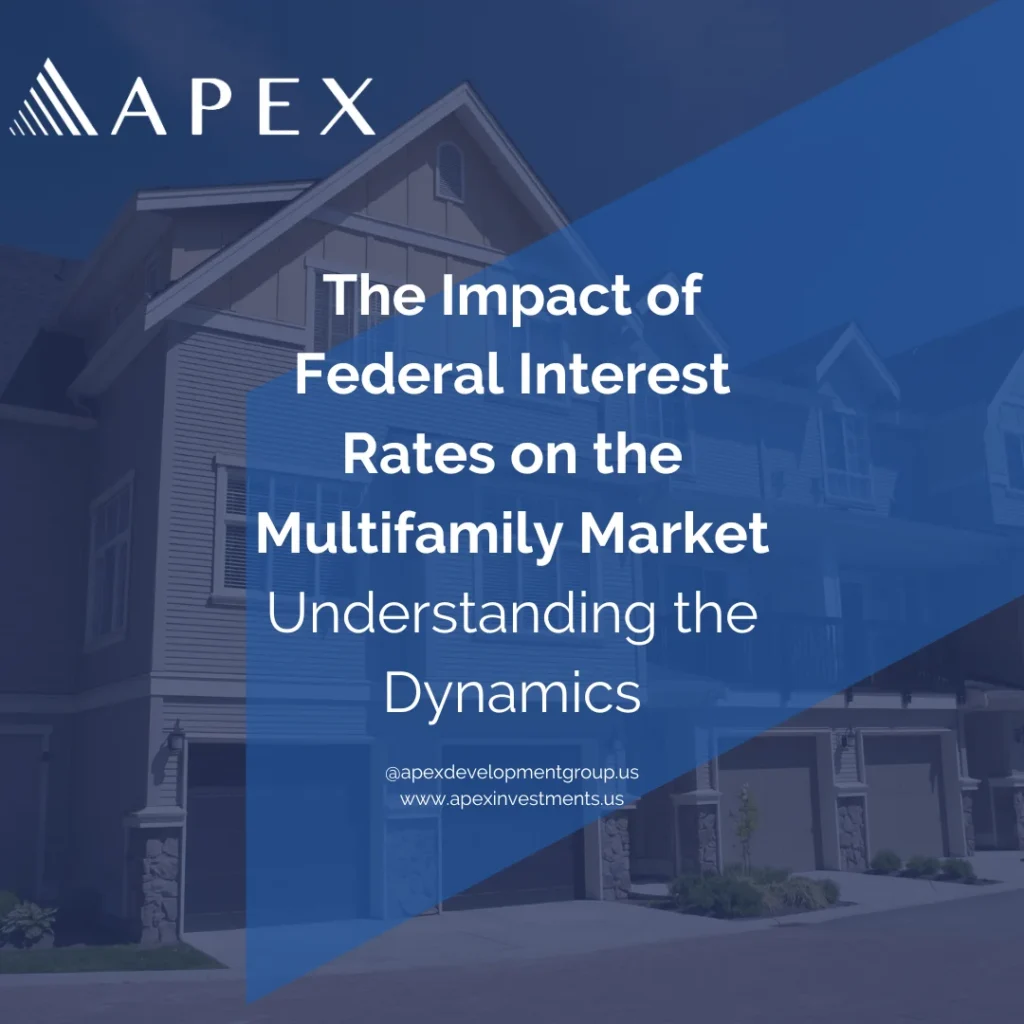
Home Impact of Federal Interest Rates on The Multifamily Market Blog · May 29, 2023 Federal Interest Rates refers to the rates at which depository institutions (mainly commercial banks), lend and borrow funds held at the Federal Reserve. The Federal Funds Rate serves as the benchmark rate for banks and other depository institutions when determining the interest rates at which they will lend money to third parties. To simplify this definition, let’;s imagine you are a bank preparing to lend money to a real estate developer. The first factor you consider when determining the lending rate to the developer is the rate at which you can borrow money. Based on that, you calculate an additional percentage (spread) to ensure profitability. In this article we will talk about the impact of Federal Interest Rates in the Multifamily Market.Following this line of thought, higher Federal Interest Rates result in increased borrowing costs. In multifamily deals, the capital structure typically consists of a significant portion of debt. Consequently, during periods of high interest rates, investors experience reduced cash flow due to higher monthly interest payments to lenders. However, there are strategies available to mitigate and understand the impact of Federal Interest Rates on the Multifamily market. How do Multifamily Investors protect themselves from rising interest rates? When entering debt obligations with fixed rates for multifamily projects, structuring companies often engage in rate cap agreements with third parties. A rate cap agreement can be likened to an insurance policy designed to protect against rising interest rates. Under this agreement, a strike rate is negotiated, and if the interest rate exceeds the strike rate, the borrower receives payments from the third party to compensate for the excess increase beyond the strike rate.To illustrate with an example, assume that you borrow $1000 at a rate of 4% + SOFR, now of the purchase, the SOFR sits at 2% and its value increases as the Federal Funds Rate increases. Therefore, your overall rate is 6% at the same time, you engage in a rate cap agreement with a SOFR strike rate of 3%. Please see below a summary of what would happen as the SOFR rises. Notional Margin Total SOFR Total Rate Interest Payment Strike Rate Rate Cap Reimbursement Net Payment $ 1,000 4.00% 2.00% 6.00% $5.00 3% – $5.00 $ 1,000 4.00% 2.50% 6.50% $5.42 3% – $5.42 $ 1,000 4.00% 3.00% 7.00% $5.83 3% – $5.83 $ 1,000 4.00% 3.50% 7.50% $6.25 3% $0.42 $5.83 $ 1,000 4.00% 4.00% 8.00% $6.67 3% $0.83 $5.83 As you may have noticed, when the SOFR rate exceeds the strike price, the net payment will always be the same, because the inflows received as a part of the rate cap reimbursement will offset the higher interest payment.Always make sure that you are investing in a reputable Multifamily Structuring Firm that has the expertise needed to hedge against interest rate risk.
